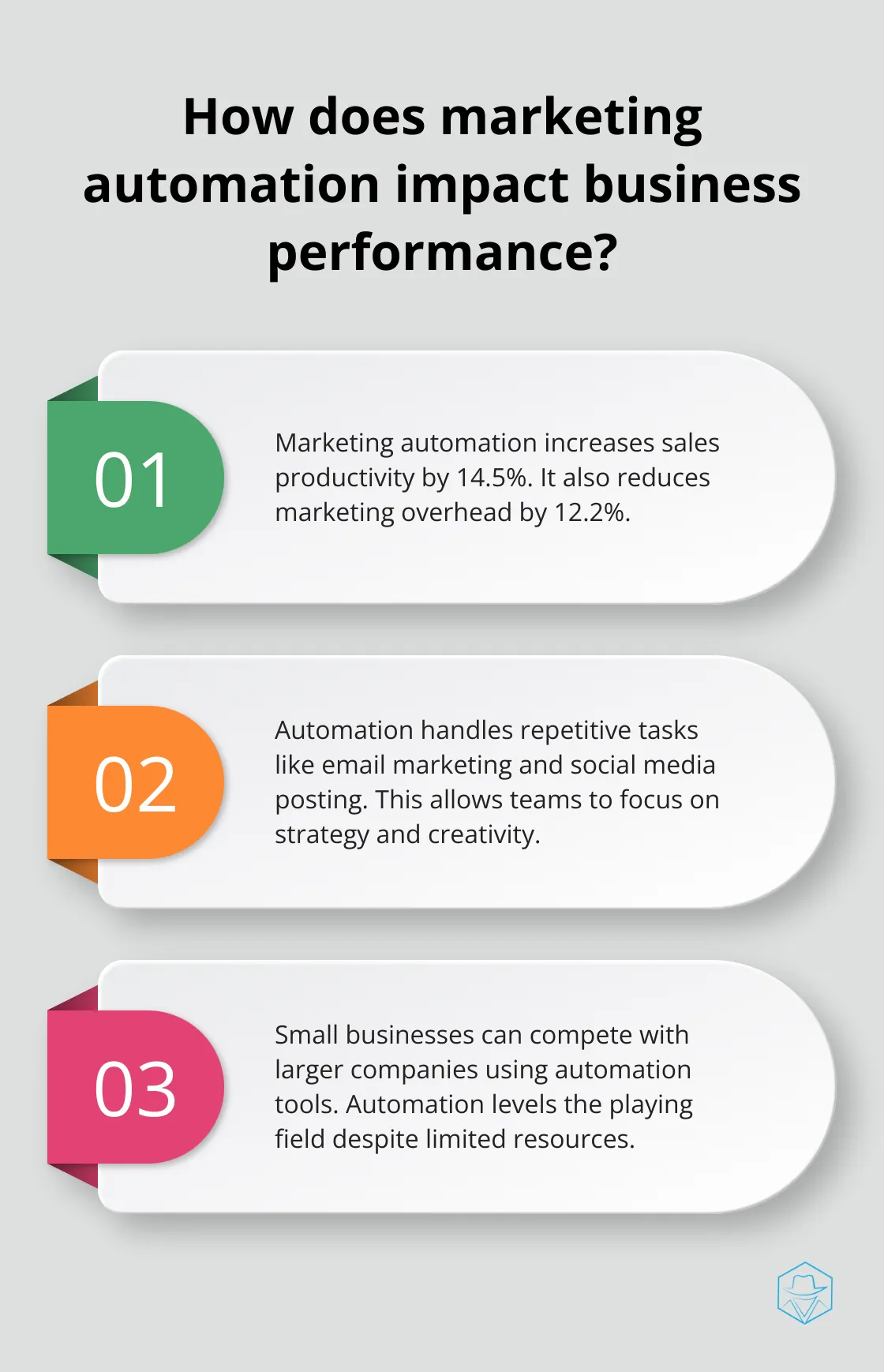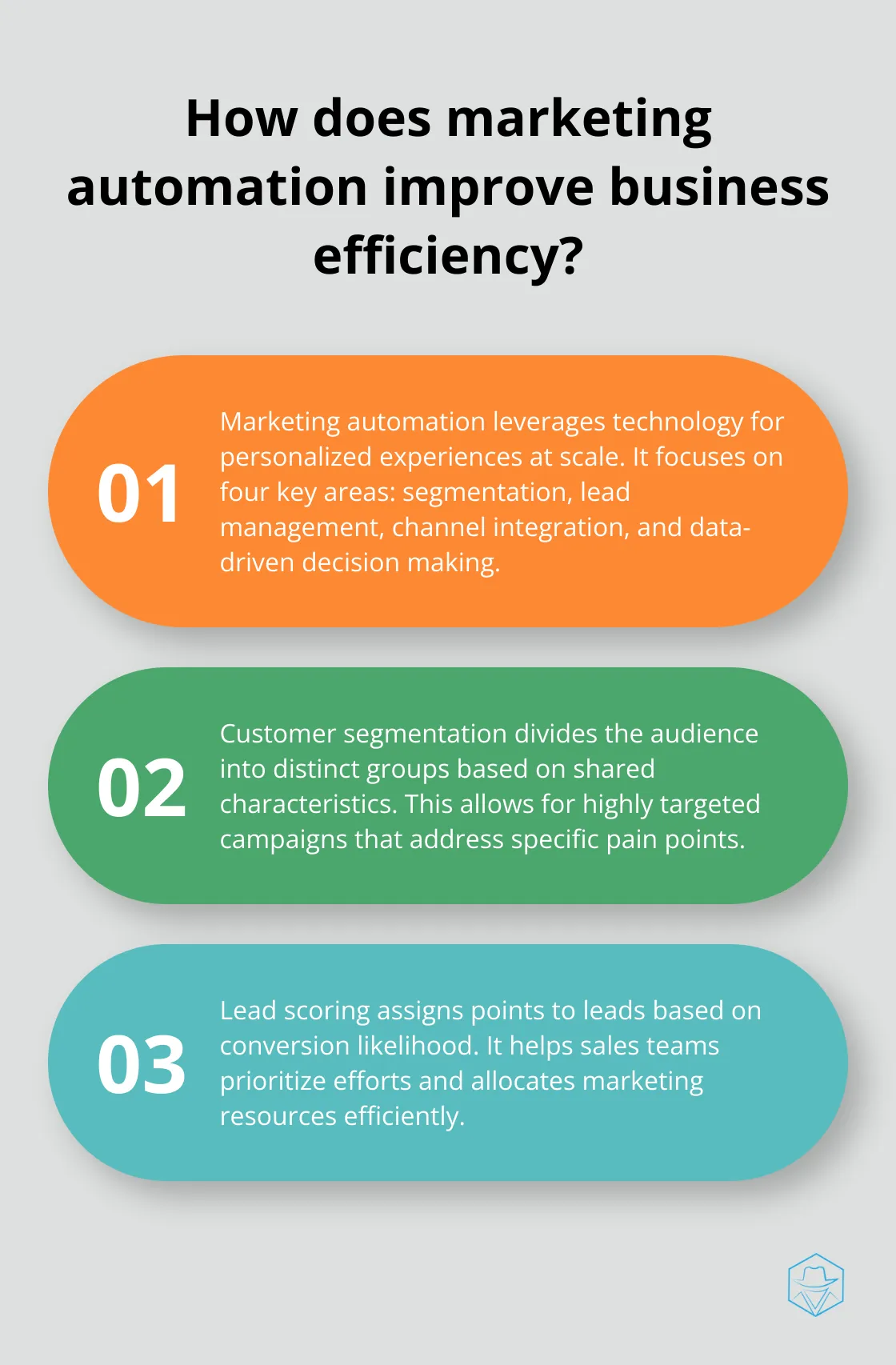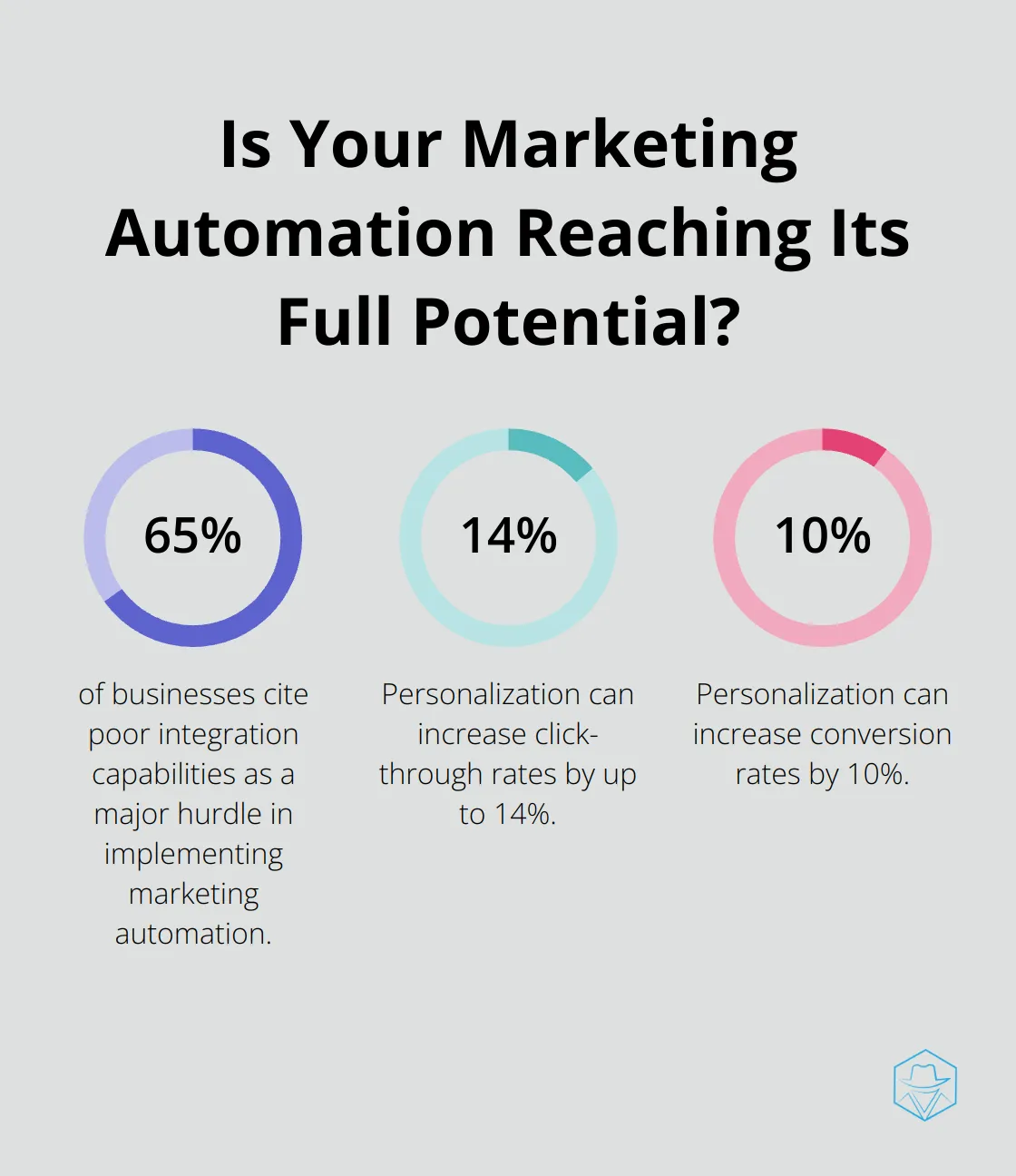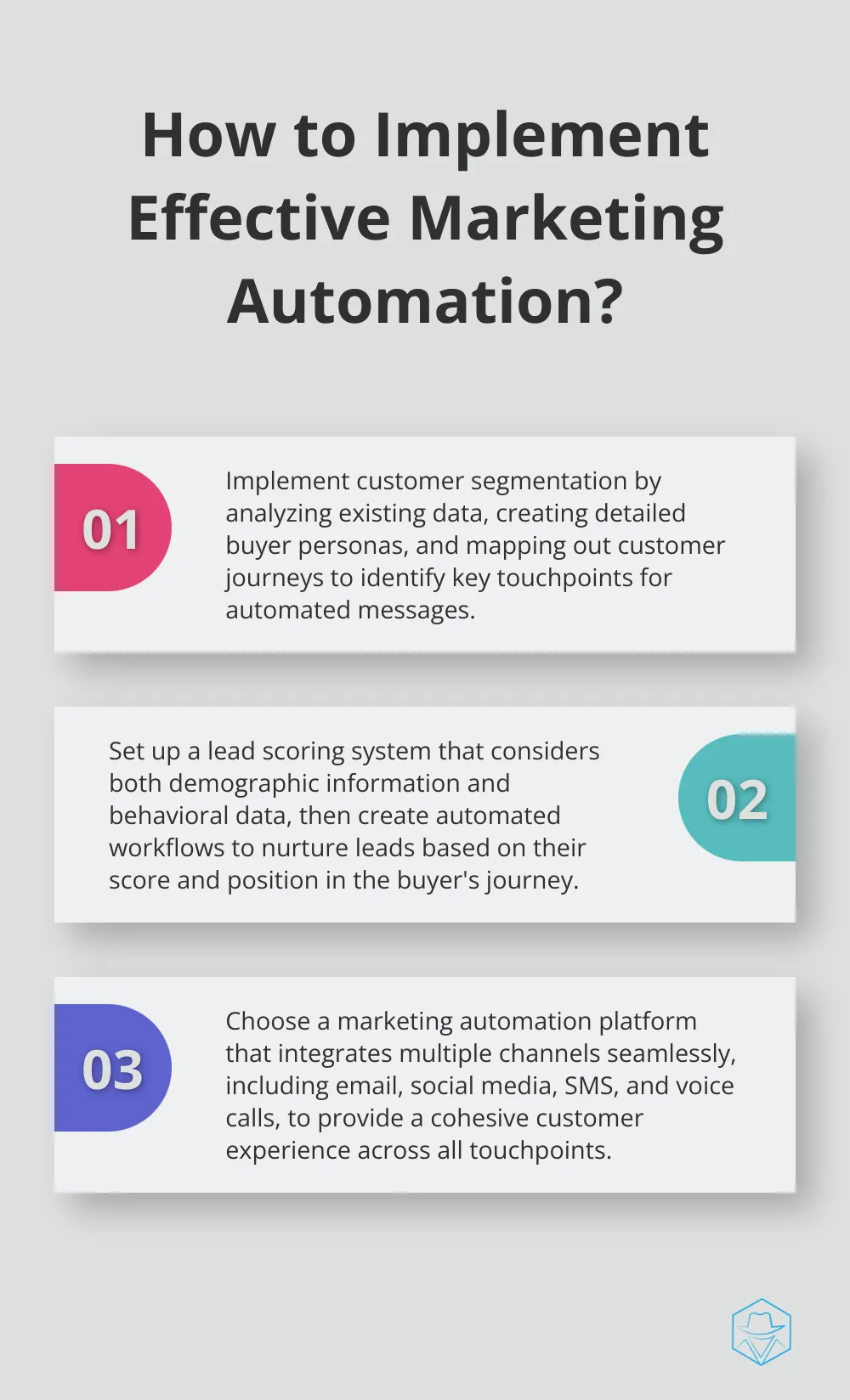Marketing Automation Strategy: Key Elements to Consider

At Drop Cowboy, we’ve seen firsthand how a well-crafted marketing automation strategy can transform businesses. Marketing automation has become an essential tool for companies looking to streamline their processes and boost their bottom line.
In this post, we’ll explore the key elements of a successful marketing automation strategy and how you can implement them in your business. We’ll cover everything from customer segmentation to choosing the right platform, giving you the knowledge you need to take your marketing efforts to new heights.
What Is Marketing Automation?
Marketing automation revolutionizes businesses of all sizes. It uses software to automate repetitive marketing tasks, allowing teams to concentrate on strategy and creativity instead of manual processes.
Core Components of Marketing Automation
The foundation of marketing automation includes:
- Email marketing
- Social media posting
- Ad campaigns
- Lead generation
These elements work in harmony to create a seamless marketing experience for both teams and customers.
For instance, when a potential customer subscribes to a newsletter, an automated email sequence nurtures that lead without manual intervention. This process adapts based on customer interactions, ensuring they receive relevant content at optimal times.
Efficiency and ROI Boost
Marketing automation significantly improves efficiency and return on investment (ROI). A study by Nucleus Research reveals that marketing automation drives a 14.5% increase in sales productivity and a 12.2% reduction in marketing overhead.

Small businesses benefit as much as large corporations from automation. With limited resources, smaller teams can compete with larger companies on a more level playing field (thanks to the power of automation).
Dispelling Common Myths
Myth 1: Automation Is Impersonal
Contrary to popular belief, marketing automation isn’t impersonal or spammy when executed correctly. It enables more personalized communication at scale. Businesses can send highly targeted messages that resonate with their audience by leveraging data and behavioral triggers.
Myth 2: Only for Tech-Savvy Marketers
While there’s a learning curve, many platforms prioritize user-friendliness. Businesses of all technical levels successfully implement automation tools (even those with limited tech expertise).
Myth 3: Replaces Human Creativity
Marketing automation doesn’t replace human creativity or strategy. It enhances these elements by handling repetitive tasks, allowing marketers to focus on high-level strategy and content creation. Thoughtful implementation leads to more engaging, personalized, and effective marketing campaigns.
As we explore the key elements of a successful marketing automation strategy, it’s essential to understand how these components work together to create a powerful marketing machine. Let’s examine the critical factors that contribute to a well-executed automation plan.
How to Craft a Winning Marketing Automation Strategy
Marketing automation transforms businesses by leveraging technology to deliver personalized experiences at scale. A comprehensive strategy focuses on four key areas: segmentation, lead management, channel integration, and data-driven decision making.
Master Customer Segmentation
Effective segmentation forms the foundation of any successful marketing automation strategy. Divide your audience into distinct groups based on shared characteristics to tailor your messaging. A B2B software company might segment its audience by industry, company size, and job role (allowing for highly targeted campaigns that address specific pain points).

To implement segmentation:
- Analyze existing customer data
- Identify patterns in purchase history, engagement levels, and demographics
- Create detailed buyer personas
- Map out the customer journey for each persona
- Identify key touchpoints for automated messages
Perfect Lead Scoring and Nurturing
Lead scoring assigns points to leads based on their conversion likelihood. This process helps sales teams prioritize efforts and allocates marketing resources efficiently. A well-designed lead scoring system considers both demographic information (job title, company size) and behavioral data (website visits, email opens, content downloads).
After implementing lead scoring, nurture leads through automated workflows. These workflows should deliver relevant content based on the lead’s score and position in the buyer’s journey. For example, a high-scoring lead interested in a specific product might receive a series of emails highlighting customer success stories and detailed product information.
Integrate Multiple Channels Seamlessly
Modern customers interact with brands across various channels, including email, social media, SMS, and voice calls. A successful marketing automation strategy must integrate these channels to provide a cohesive experience. Platforms that offer seamless integration of ringless voicemail and SMS alongside traditional email marketing excel in this area.
When implementing multi-channel automation:
- Create consistent messaging across all touchpoints
- Use data from one channel to inform strategy on others
- Adjust communication preferences based on customer engagement
Leverage Data Analytics for Improvement
Marketing automation generates vast amounts of data on customer behavior and campaign performance. To harness this power, robust analytics and reporting capabilities are essential. Look for a platform that offers real-time dashboards and customizable reports aligned with your key performance indicators (KPIs).
Regular analysis of automation data reveals valuable insights. You might discover that certain content types perform better at specific times of day, or particular segments respond more favorably to certain offers. Use these insights to refine your automation strategy continuously, and A/B test different approaches to optimize results.
Marketing automation requires ongoing monitoring and adjustment to ensure maximum effectiveness. The next chapter will explore how to choose the right marketing automation platform and set clear goals to support your strategy.
How to Implement Your Marketing Automation Strategy
Select the Right Platform
The selection of an appropriate marketing automation platform is essential. Your chosen solution should align with your business needs and integrate with your existing tools. For example, if voice and SMS marketing are your focus, platforms that offer specialized features like ringless voicemail and SMS integration can boost your campaign effectiveness significantly.

When you evaluate platforms, consider scalability, ease of use, and customer support. A 2023 Gartner report indicates that 65% of businesses cite poor integration capabilities as a major hurdle in implementing marketing automation. Ensure that your chosen platform can grow with your business and offers robust integration options.
Define Clear Objectives
The establishment of clear, measurable goals is vital for success. Start by identifying your key performance indicators (KPIs). These may include lead generation rates, conversion rates, or customer retention metrics. Be specific – instead of a general aim to increase leads, set a target like increasing qualified leads by 25% in the next quarter.
A Content Marketing Institute study found that marketers who set documented goals are 429% more likely to report success. Take time to outline your objectives and share them with your team. This clarity will guide your automation efforts and help you measure progress effectively.
Craft Compelling Content
Content acts as the fuel that powers your marketing automation engine. Create a content strategy that aligns with your customer journey and addresses pain points at each stage. HubSpot reports that businesses which prioritize blogging are 13 times more likely to see positive ROI.
When you create content for automation, focus on personalization. Use dynamic content blocks that change based on user data. You might customize email content based on the recipient’s industry or past interactions with your brand. This level of personalization can increase click-through rates by up to 14% and conversion rates by 10% (as reported by Aberdeen Group).
Prepare Your Team
The success of your marketing automation strategy depends on your team’s ability to use the tools effectively. Invest in comprehensive training for your marketing and sales teams. This includes not just technical training on the platform but also education on best practices for creating automated workflows and analyzing data.
Try to foster a culture of continuous learning and improvement. Encourage team members to share insights and experiment with new approaches. Regular check-ins and strategy sessions can help keep everyone aligned and motivated.
Monitor and Adjust
Implementation of marketing automation is an ongoing process. Review your strategy regularly, analyze results, and make data-driven adjustments. Set up a system for continuous monitoring and improvement (this could involve weekly team meetings or monthly performance reviews). This approach allows you to refine your automation tactics based on real-world results and changing market conditions.
Final Thoughts
A well-executed marketing automation strategy revolutionizes business operations and drives significant growth. Mastering customer segmentation, lead scoring, and multi-channel integration sets the stage for long-term success. Data analytics empowers teams to focus on high-value tasks, fostering innovation and creativity within organizations.

Businesses should assess current processes and identify areas where automation can make the most impact. Choosing a platform that aligns with specific needs and goals is essential. Drop Cowboy offers a comprehensive solution that combines ringless voicemail, SMS integration, and AI-powered voice cloning to enhance marketing efforts.
Successful implementation requires ongoing commitment and regular strategy reviews. Companies must analyze results and make data-driven adjustments (this process never ends). Investing in team training and fostering a culture of continuous improvement will transform a marketing automation strategy into a powerful engine for business growth.
blog-dropcowboy-com
Related posts

July 1, 2025
Is There an Alternative to ActiveCampaign?
Explore top alternatives to ActiveCampaign with our guide, featuring comparisons and practical tips for finding the right solution for your business needs.

April 14, 2025
How to Create Effective Email Templates for Shopify
Create effective email templates for Shopify to boost engagement and sales. Learn key strategies and practical tips to improve your Shopify email campaigns.

September 3, 2025
Effective SMS Strategies for Customer Retention and Loyalty
Boost loyalty and retention with effective SMS retention strategies. Learn actionable techniques to keep your customers engaged and satisfied.

April 17, 2025
Best Shopify Apps to Boost Your Online Store
Boost sales with the best Shopify apps. Discover top tools to enhance functionality, improve customer experience, and streamline your online store.

June 16, 2025
Crafting the Perfect Message for Direct-to-Voicemail Campaigns
Your message is only powerful if it’s actually heard. In today’s distracted world, a solid voicemail campaign is your frontline. But how can you get more people to engage with voicemail? According to data from RESimpli, 87% of Americans don’t answer calls from numbers they don’t know. Because of this, 80% of calls go directly to voicemail, […]

June 5, 2025
Predictive Outbound Dialer: Revolutionize Your Call Center
Boost efficiency and sales with a predictive outbound dialer. Learn how these tools transform call centers and improve customer engagement.